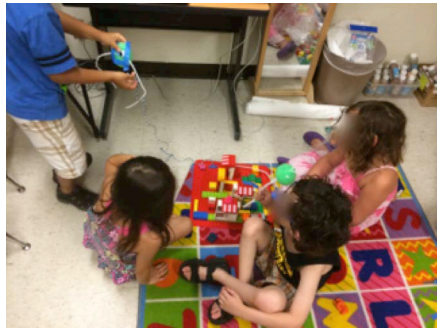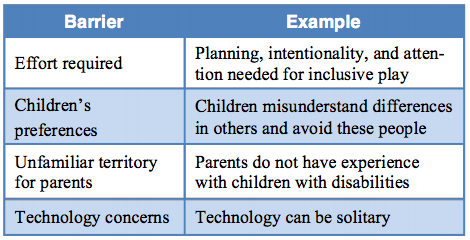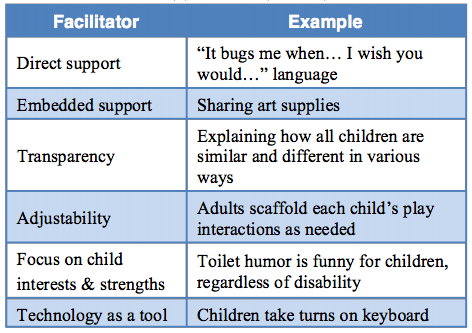 Inclusive play, defined as play among children with and without disabilities, provides learning opportunities that challenge stereotypes, foster strong friendships, and help children develop empathy and other social and emotional skills. Designing technologies to support inclusive play are understudied in Human-Computer Interaction. We synthesized literature, conducted design ethnography in an inclusive classroom, and interviewed and surveyed parents and teachers to explore this problem. Our research contributes an empirical understanding of the current state of inclusive play and a characterization of the design space for interactive technologies that can support children and adults with inclusive play. We identify key facilitators of inclusive play: direct and embedded supports, transparency, adjustability, emphasis on children’s interests and strengths, and current technology use. We also describe significant barriers to inclusive play: effort required to facilitate inclusive play, children’s preferences, parental inexperience, and inappropriate technology. Through our discussion, we conclude that interactive technologies should be designed to harness the facilitators and help overcome the barriers in order to maximize children’s opportunities with inclusive play. This work was published at IDC 2015.
Inclusive play, defined as play among children with and without disabilities, provides learning opportunities that challenge stereotypes, foster strong friendships, and help children develop empathy and other social and emotional skills. Designing technologies to support inclusive play are understudied in Human-Computer Interaction. We synthesized literature, conducted design ethnography in an inclusive classroom, and interviewed and surveyed parents and teachers to explore this problem. Our research contributes an empirical understanding of the current state of inclusive play and a characterization of the design space for interactive technologies that can support children and adults with inclusive play. We identify key facilitators of inclusive play: direct and embedded supports, transparency, adjustability, emphasis on children’s interests and strengths, and current technology use. We also describe significant barriers to inclusive play: effort required to facilitate inclusive play, children’s preferences, parental inexperience, and inappropriate technology. Through our discussion, we conclude that interactive technologies should be designed to harness the facilitators and help overcome the barriers in order to maximize children’s opportunities with inclusive play. This work was published at IDC 2015.


People
Kiley Sobel
Katie O’Leary
Julie Kientz
Publication
- Sobel, K., O’Leary, K., & Kientz, J. A. (2015, June). Maximizing children’s opportunities with inclusive play: considerations for interactive technology design. In Proceedings of the 14th International Conference on Interaction Design and Children (pp. 39-48). ACM.
